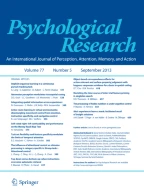Abstract.
In the first phase of Experiment 1, participants were instructed to move a response key up or down in response to a go signal. One of both responses was consistently followed by an aversive stimulus, whereas the other response was never followed by the aversive stimulus. In a subsequent test phase, the same responses had to be emitted according to the grammatical category (noun or adjective) of positive and negative target words. Results showed that the level of affective correspondence between the task-irrelevant positive or negative connotation of the target and the motivational significance of the effect of the correct response influenced performance. The results of Experiment 2 replicated those of Experiment 1, using alternating target-response assignment. These findings point to the integration of affective action effect feature codes in the cognitive representation of actions.
Similar content being viewed by others
Author information
Authors and Affiliations
Additional information
Electronic Publication
Rights and permissions
About this article
Cite this article
Beckers, T., De Houwer, J. & Eelen, P. Automatic integration of non-perceptual action effect features: the case of the associative affective Simon effect. Psychological Research 66, 166–173 (2002). https://doi.org/10.1007/s00426-002-0090-9
Received:
Accepted:
Issue Date:
DOI: https://doi.org/10.1007/s00426-002-0090-9
